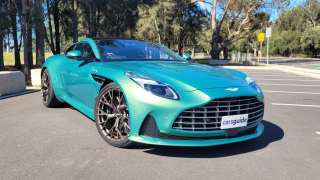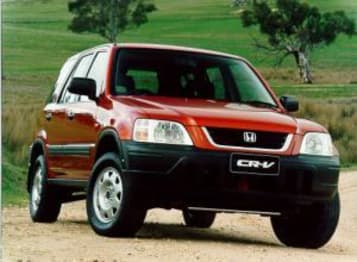
Used Honda CR-V review: 1997-2001
- Honda CR-V
- Honda CR-V 1997
- Honda CR-V 1998
- Honda CR-V 1999
- Honda CR-V 2000
- Honda CR-V 2001
- Honda CR-V Reviews
- Honda Reviews
- Honda SUV Range
- SUV
- Honda
- Used Car Reviews
- Family Car

The SUV market was still in its infancy when Honda launched its first CR-V in 1997, and many regard that compact all-wheel drive Honda town-biased light-duty off-road wagon as the car that ignited demand for the all-new genre of family car.
Before the CR-V there was the Toyota RAV4, but the Toyota was aimed quite specifically at fun-loving youngsters and older couples wanting to rediscover their youth (having managed to convince their kids to leave home). It wasn’t a car designed for families, but the CR-V was.
Model Watch
With the SUV market still something of an unknown the initial range of CR-V models was limited, it was a toe-in-the-water exercise to gauge Australians’ appetite for something new.
When it launched in 1997 there was just one model, which was simply badged CR-V. That was joined in 1999 by the CR-V Sport once the SUV’s appeal had started to take affect and sales were beginning to grow.
Both models were high riding compact all-wheel drive wagons that looked similar to the big, tough four-wheel drives we were all familiar with, but had none of the hardships of the big off-road bruisers.

They had an economical 2.0-litre four-cylinder engine, there was a choice of manual gearbox or automatic transmission, and it boasted on-demand all-wheel drive.
The entry model, the CR-V, had a relatively short list of standard features, they included air conditioning, remote central locking, power windows and mirrors, power steering, a tilt-column, a radio/cassette player with four speakers, an immobilizer, and metallic paint. Safety features were limited to dual front airbags.
An update in 1999 brought minor cosmetic changes and more power for the 2.0-litre engine, but the big news was the addition of the new Sport model.

Additional features of the Sport over the base model included ABS anti-lock braking, a power sunroof, roof racks, and alloy wheels.
Coming as it did in the late-1990s the CR-V didn’t boast climate control for the air-conditioning, sat nav, or a touch screen, and pre-dating Bluetooth it wasn’t possible to connect an iPhone or Android device.
It didn’t have modern parking features, such as a reversing camera, parking sensors, or an automatic park assist system either.
The tailgate-mounted spare tyre was full-sized.
Cabin
With four doors and seats for five the CR-V was well suited to family use.
The rear seat was a split-fold type, which afforded even greater flexibility for carrying sporting gear or luggage.
A high seating position was an appealing feature of the CR-V for the good visibility in traffic it afforded drivers in an increasingly congested driving environment.

Its upright, boxy shape resulted in a roomy cabin, with comfortable accommodation for five, and decent space left over for luggage.
Lap/sash seat belts facilitated fitment of a baby car seat, but there were no ISOFIX mounting points.
Cupholders were provided in the dash and centre console.
Engine
Being a Honda the 2.0-litre four-cylinder engine was a relatively sophisticated one for the time, with double overhead camshafts, four-valves per cylinder, and multi-point fuel-injection.
At launch in 1997 it boasted power and toque peaks of 94kW (126 horsepower) and 182Nm respectively.
The power was increased to 108kW (145 horsepower) in 1999, but there was no increase in torque output.

Performance was modest, but with the increased power the CR-V could complete the 0-100 km/h sprint in a time of 10.4 seconds.
Honda recommended the use of 91-octane regular unleaded petrol.
To get the best out of the four-cylinder engine you needed the five-speed manual gearbox and stir it along, but most buyers chose the four-speed automatic, which put a dampener on the zip.
Driving
Although it was talked of as a four-wheel drive, the CR-V was really what we now refer to as an ‘on-demand’ all-wheel driver.
For most of the time it operated as a regular front-wheel drive car, until the electronics detected wheel slip at the front wheels when some of the drive was then directed to the rear wheels.
The system, while effective on loose or slippery surfaces, wasn’t suitable for real off-road use.
Limited ground clearance was also a limiting factor of the CR-V off-road.
On road the CR-V went reassuringly where it was pointed, the handling was balanced without being sporty, and ride was comfortable.
Safety
While the first CR-V was well equipped with safety features for the time, it lacked the features we’ve come to expect of a car today.
All models had front airbags for the driver and front seat passenger, but only the Sport boasted ABS anti-lock braking.
The CR-V was given a three-star Driver Protection Rating in the Used Car Safety Rating report, which makes it ‘marginal’ under the report’s five-star system.
Any common issues?
The first CR-V is now more than 20 years old, and that alone should signal careful and close assessment is needed when buying one today.
Like all Hondas it was a soundly designed and quality built car when new, but age and kilometres driven affect all cars, no matter the brand.
Owners tell us it has impeccable reliability, and that even now they only have to replace the usual wear-and-tear suspects like brakes and tyres, but that requires regular and competent servicing.
Hondas, with their jewel-like engines and tight tolerances need regular oil changes to keep ticking over in tip-top shape.
It is crucial to check for a service record, one that is credible. If a car doesn’t have that, or appears to have been neglected in any way, walk away.
The cam-timing belt needs to be replaced every 160,000km; ignoring it can lead to serious and expensive internal damage to the engine.
But looked after, the CR-V stands up well over time.
The first CR-V predated capped price servicing, but service costs are not excessive and any experienced mechanic can do it.
The warranty when new was for three-years/80,000km, but that has long since expired.
Owners view
Jim Watson: I love the 2001 Sport I bought in 2016. It has heaps of room inside, I love the sunroof, and it’s been a great all-round family car.
Steph Blackstone: I bought my Sport manual in 2015 and it’s perfect for my use; it’s got decent space for a pram, a child seat and toys. I also like the economy, the performance, and the safety of the four-wheel drive.
Manny Petrakis: I bought my Sport new in 1999. Its performance is good, the economy could be better, the ride is firmish, but the reliability has been outstanding.
Terry Goodes: We’ve had an excellent run with our 2000 Sport in the six years we’ve owned it. It’s bulletproof; we’ve never had to replace anything other than brakes and tyres. Our only complaint is the road noise on the highway.
Rivals
Subaru Forester
Practical, safe all-wheel drive wagon a sensible choice.
Suzuki Vitara
Surprisingly capable off-road, but lacks city comfort.
Toyota RAV4
Early Toyota was more singles funster than family transporter.
Verdict
Honda build quality assures a sound and reliable used car choice, if well cared for.
Pricing
| Year | Price From | Price To |
|---|---|---|
| 2001 | $2,310 | $6,380 |
| 2000 | $2,310 | $5,280 |
| 1999 | $2,310 | $5,280 |
| 1998 | $2,860 | $5,280 |
| 1997 | $2,860 | $5,280 |
Pricing guides
Range and Specs
| Vehicle | Specs | Price* | |
|---|---|---|---|
| (4X4) | 2.0L, ULP, 5 SP MAN 4X4 | $3,410 – 5,280 | 1997 Honda CR-V 1997 (4X4) Pricing and Specs |
Other cars to consider
$2,860
Lowest price, based on third party pricing data










